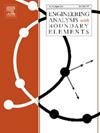Rockburst proneness analysis of rock materials based on the discrete element method
IF 4.2
2区 工程技术
Q1 ENGINEERING, MULTIDISCIPLINARY
Engineering Analysis with Boundary Elements
Pub Date : 2024-11-22
DOI:10.1016/j.enganabound.2024.106047
引用次数: 0
Abstract
To explore the rockburst proneness of rock materials, coarse-grained granite, red sandstone and white marble were selected for uniaxial compression laboratory tests. Applying the rockburst proneness criterion based on the peak strength strain storage index, numerical models of the three rocks were constructed according to the three-dimensional Clump (3D-Clump) modelling method using the three-dimensional Particle Flow Code (PFC3D) in the Discrete Element Method (DEM). Numerical simulations of conventional uniaxial compression (UC) and single cyclic loading-unloading uniaxial compression (SCLUC) tests were carried out to estimate the rockburst proneness of the three rocks. The results show that the 3D-Clump model can match different types of rock materials by setting the proper clump radius and meso parameters. The stress-strain curves in the UC numerical simulation tests of the three rocks are very similar to those of laboratory tests. In the SCLUC numerical simulation tests, the peak strengths of the three rocks at different unloading stress levels k do not differ by more than 5 % from that of the conventional UC tests. Based on the rockburst proneness criterion of the peak strength strain storage index, combined with the final fracture modes in the SCLUC tests, it is concluded that coarse-grained granite has high rockburst proneness, and red sandstone and white marble have low rockburst proneness.
基于离散元法的岩石材料岩爆易发性分析
为了探究岩石材料的岩爆性,选择了粗粒花岗岩、红砂岩和白色大理岩进行单轴压缩实验室试验。根据基于峰值强度应变存储指数的岩爆标准,使用离散元法(DEM)中的三维粒子流代码(PFC3D),按照三维岩块(3D-Clump)建模方法构建了这三种岩石的数值模型。对常规单轴压缩(UC)和单次循环加载-卸载单轴压缩(SCLUC)试验进行了数值模拟,以估算这三种岩石的易爆性。结果表明,通过设置适当的岩块半径和中间参数,三维岩块模型可以匹配不同类型的岩石材料。三种岩石在 UC 数值模拟试验中的应力-应变曲线与实验室试验的应力-应变曲线非常相似。在 SCLUC 数值模拟试验中,三种岩石在不同卸荷应力水平 k 下的峰值强度与传统 UC 试验的峰值强度相差不超过 5%。根据峰值强度应变存储指数的易爆性标准,结合 SCLUC 试验的最终断裂模式,可以得出结论:粗粒花岗岩的易爆性较高,红砂岩和白色大理岩的易爆性较低。
本文章由计算机程序翻译,如有差异,请以英文原文为准。
求助全文
约1分钟内获得全文
求助全文
来源期刊

Engineering Analysis with Boundary Elements
工程技术-工程:综合
CiteScore
5.50
自引率
18.20%
发文量
368
审稿时长
56 days
期刊介绍:
This journal is specifically dedicated to the dissemination of the latest developments of new engineering analysis techniques using boundary elements and other mesh reduction methods.
Boundary element (BEM) and mesh reduction methods (MRM) are very active areas of research with the techniques being applied to solve increasingly complex problems. The journal stresses the importance of these applications as well as their computational aspects, reliability and robustness.
The main criteria for publication will be the originality of the work being reported, its potential usefulness and applications of the methods to new fields.
In addition to regular issues, the journal publishes a series of special issues dealing with specific areas of current research.
The journal has, for many years, provided a channel of communication between academics and industrial researchers working in mesh reduction methods
Fields Covered:
• Boundary Element Methods (BEM)
• Mesh Reduction Methods (MRM)
• Meshless Methods
• Integral Equations
• Applications of BEM/MRM in Engineering
• Numerical Methods related to BEM/MRM
• Computational Techniques
• Combination of Different Methods
• Advanced Formulations.
 求助内容:
求助内容: 应助结果提醒方式:
应助结果提醒方式:


